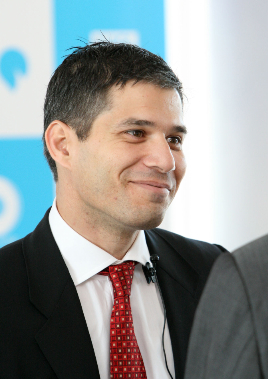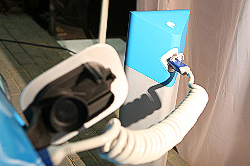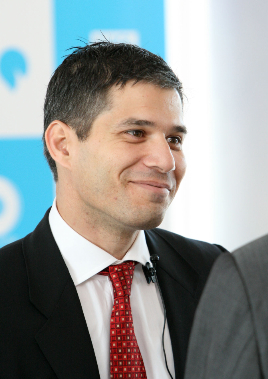The more you talk to Shai Agassi, the more the Steve Jobs comparison seems apt.
 Shai AgassiCourtesy Better PlaceLike his fellow Silicon Valley impresario, Agassi, the founder of electric car infrastructure startup Better Place, is as much a green-tech visionary as entrepreneur bent on cashing in on the “Next Big Thing.” Just as Jobs elegantly married hardware and software to create the iPod and iPhone and disrupted the telecommunication-entertainment industrial complex, Agassi aims to do the same with transportation.
Shai AgassiCourtesy Better PlaceLike his fellow Silicon Valley impresario, Agassi, the founder of electric car infrastructure startup Better Place, is as much a green-tech visionary as entrepreneur bent on cashing in on the “Next Big Thing.” Just as Jobs elegantly married hardware and software to create the iPod and iPhone and disrupted the telecommunication-entertainment industrial complex, Agassi aims to do the same with transportation.
In case you missed the spate of national magazine stories on the former software executive and his company, Better Place has signed deals with governments in Israel, Denmark, Australia, California, Hawaii and Canada to build a web of electric car charging spots and battery-swapping stations.
Agassi aims to crack the chicken-and-egg electric vehicle dilemma by deploying the infrastructure that will give automakers the confidence to make carbon-free cars by the tens of millions while allaying drivers’ “range anxiety” that they’ll run out of juice on the way to grandma’s house. Better Place will own your car’s battery and sell you electricity by the mile (or kilometer) like your mobile phone company sells you minutes.
Better Place is not the only company pushing that model, but no competitor has raised as much money — more than $200 million so far — or signed deals with national governments to electrify their roadways.
Then there’s the Agassi factor.
If Steve Jobs is a distant, “cult of personality” figure, making semi-annual pronouncements before the party faithful in a never-changing uniform of running shoes, jeans and turtleneck, Agassi is the Gen X enviro-evangelist in a sharply cut black suit, appearing before audiences large and small to sell the story of making the world a better place through electric transportation.
I sat down with Agassi recently to get an update on Better Place’s progress and delve into just how the company plans to make money off a capital-intensive venture that will depend on an emerging EV ecosystem of carmakers, battery manufacturers and utilities, not to mention government policymakers.
Slight and dark-haired with a penetrating gaze, Agassi possesses Jobs’ supreme charismatic self-confidence — “The internal combustion engine is dead,” he tells me matter-of-factly — and parries every question with a ready set of facts and figures. We met at Fortune Magazine’s Brainstorm Green conference in Southern California a few weeks before the scheduled May 13 unveiling of Better Place’s prototype battery switching station in Japan. (Why Japan? “They paid for it,” he says. “Japan is the most robust manufacturing and they fear being wrong” on electric cars.)
Think of Better Place’s battery switching station as the electric version of gas station. Most of the time Better Place subscribers will top off their batteries at home or at battery charging posts — about the size of a parking meter — scattered around cities and suburbs. For trips that exceed a car’s range, they’ll pull into a switching station where a robot will unlatch a panel underneath the vehicle and remove the battery pack, install a fresh battery and close and lock the panel. Total time: About 40 seconds. The depleted battery is then recharged so it’s ready for the next customer. Each Better Place station will cost about half million dollars and will maintain a store of 10 batteries.
“We’ve done tests where we’ve swapped the battery 200 times a day on a car,” Agassi says. “It feels like a car wash more than anything else.”
For $25 million, according to Agassi, Better Place could electrify the West Coast’s Interstate 5 corridor.
So far, Renault-Nissan is the only automaker that has pledged to manufacture an electric car with a battery pack configuration compatible with the Better Place switching station. No worries, says Agassi, noting that in Israel — the first country that will deploy a nationwide Better Place network — the company has already taken more than 20,000 orders for electric Renaults. He says that’s enough to break even on Better Place’s initial $200 million investment in 100 switching stations and 100,000 charging posts. At somewhere between 20,000 and 40,000 cars, Better Place turns a profit, according to Agassi, who notes that there are about 2 million cars on the road in Israeli and that about 200,000 cars were sold there in 2008.
Israel, a relatively tiny country, is one thing. But the suburbanized and continent-wide United States will require a much bigger investment in infrastructure. Agassi estimates that to do the initial build out of the San Francisco Bay Area, he’ll need Northern Californians to buy between 40,000 and 50,000 electric vehicles — no small number. When Better Place announced the $1 billion Bay Area deal with the mayors of San Francisco, San Jose and Oakland last year, no automaker had committed to providing the electric cars, though Renault-Nissan has pledged to begin putting EVs in mass production by 2012.
 A demonstration of what a Better Place charging station looks like. Watch the video at the bottom of this article for a demonstration of the company’s battery-swapping stations.Courtesy Better PlaceAgassi says he expects Better Place to earn between $4,000 and $5,000 in annual battery subscription fees per car. That would be the equivalent of buying $76 to $100 worth of gasoline a week, which seems on the high side for even a suburban commuter given current gasoline prices. That’s also far more than what Better Place’s initial urban customers likely pay for gas. Of course, the wild card is the price of gas. If it goes back up to $4 or more per gallon, Better Place’s numbers start to look more reasonable.
A demonstration of what a Better Place charging station looks like. Watch the video at the bottom of this article for a demonstration of the company’s battery-swapping stations.Courtesy Better PlaceAgassi says he expects Better Place to earn between $4,000 and $5,000 in annual battery subscription fees per car. That would be the equivalent of buying $76 to $100 worth of gasoline a week, which seems on the high side for even a suburban commuter given current gasoline prices. That’s also far more than what Better Place’s initial urban customers likely pay for gas. Of course, the wild card is the price of gas. If it goes back up to $4 or more per gallon, Better Place’s numbers start to look more reasonable.
There are plenty of critics who question whether Better Place can raise the billions needed to build just the infrastructure for the deals the company has signed so far. Others doubt that automakers and battery manufacturers will adopt standardized technology to enable, for instance, the widespread use of Better Place switching stations.
None of which, of course, fazes Agassi. He says Better Place has the cash to build the Israel network and Denmark — next up with a 2011 roll out — is financed as well. He’s hoping to tap stimulus package funds to help pay for Hawaii’s network.
“Somewhere between hundreds of thousands and millions of cars, electric vehicles are cheaper to make than gas-powered cars,” he said earlier in the day, pacing the Brainstorm Green conference stage Oprah-like. “Somewhere between now and then we get to [the equivalent of] zero dollars a barrel of oil.”
—
Below, a Better Place promotional video:
Watch another promotional video on the Better Place website.


